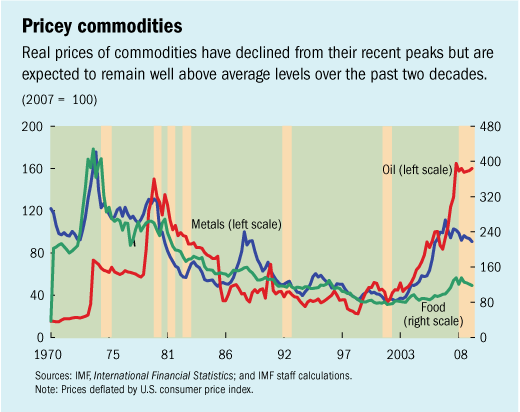
Typical street scene in Santa Ana, El Salvador. (Photo: iStock)
IMF Survey: Inflation Risks Remain Despite Slowing Growth
October 2, 2008
- Commodity prices to remain high and volatile despite recent price declines
- Headline inflation may ease, but some risks of second-round effects remain
- Further monetary policy tightening may be needed in some countries
Commodity prices will likely remain high and volatile, contributing to risks of second-round effects—such as wage hikes—across a range of emerging and developing economies, according to new IMF research.

High commodity prices have not fed fully through supply chains in many economies and could still ratchet up general inflation (photo: Newscom)
COMMODITY PRICES AND INFLATION
Further monetary policy tightening may be still relevant to contain these inflationary pressures, the research finds.
Published in an analytic chapter of the October 2008 World Economic Outlook, entitled "Is Inflation Back? Commodity Prices and Inflation," the research notes that the recent surge in food and energy prices led to widespread increases in headline inflation, particularly in emerging and developing economies.
With the decline in commodity prices from their peaks in the past few months, pressure on headline inflation is likely to ease. However, many of the forces underlying the boom are still in place and will likely keep the prices at high levels by historical standards (see chart).
Since the high commodity prices have not fed fully through the supply chain in many economies, they could still ratchet up general inflation. The economies most vulnerable to such risks of rising inflation are those with a high likelihood of the first-round effects on headline inflation spilling over into underlying inflation (the so-called "second-round effects").

Countries in which people spend a large share of their income on commodities, especially foods, are particularly at risk. Countries with limited monetary policy credibility, with price pressures from other sources such as overheating, and with inadequate macroeconomic policy responses to rising inflation so far are also vulnerable.
The commodity boom
The world economy has experienced the broadest and most sustained commodity price boom since the early 1970s. The boom has largely been driven by the interaction of strong global growth, a lack of sector-specific spare capacity and low inventories from the onset of the boom, and slow supply responses.
Also, commodity-specific factors have contributed to the recent surge in food prices, including demand related to biofuels production, supply disruptions for major crops, and trade restrictions. Cross-commodity price linkages have played an important role as well, with rising energy prices spilling into food prices. In contrast, the increasing role of commodities as alternative financial assets has had little discernible systematic impact on prices.
Notwithstanding some recent easing in commodity prices, many of the forces underlying the boom are still in place. The recent price declines reflect prospects of slowing global growth in 2008-09, the resolution of weather-related supply constraints for key food crops this year, and increased oil supply.
However, supply constraints and low inventories are likely to remain in place for some time, and growth in large emerging economies is still expected at or close to recent trends. As a result, prices will likely remain at high levels by historical standards, with considerable scope for price volatility.
Is inflation back?
Barring a sharp drop in commodity prices, inflation risks will remain elevated for some time, especially in a range of emerging and developing economies. The adjustment to the earlier commodity price surge is still in train in many of these economies, and risks of second-round effects on underlying inflation are still present. In contrast, inflation risks are diminishing rapidly in advanced economies, owing not only to the deflationary impact of the financial turmoil, but also low risks of second-round effects.
The study's empirical findings suggest that the risks of second-round effects depend importantly on the ability of monetary policy to anchor expectations and the weight of commodities—especially food—in final expenditure. Thus, a number of emerging and developing economies are more vulnerable along these dimensions and are at greater risk of unanchoring expectations and unleashing second-round effects.
A concern is that the empirical findings might underestimate the risks, as they are based on data from a period with mostly small and temporary fluctuations in commodity prices. In the circumstances, firms are less likely to pass on cost changes from commodity prices to consumers. In contrast, the recent commodity price increases have been so large and persistent that they might have set in motion a much more general price adjustment.
Dilemmas for central banks
While policymakers are concerned about financial turmoil and a severe economic slowdown, central banks in a number of emerging and developing countries still need to balance these concerns against the risks from high underlying inflationary pressures. Real policy interest rates in some of these economies are low, even in the face of growth rates at still historical highs, recent increases in core inflation, and relatively higher risks of second-round effects from high commodity prices.
In some cases, the low interest rates partly reflect policies that seek to limit fluctuations in the value of their currencies against the U.S. dollar. As a result, some economies have had to import the expansionary U.S. monetary policy stance, which was not helpful, given strong domestic demand.
The study's simulations highlight that, in a situation where inflation is already high and rising, aggressive monetary policy action is likely needed to bring down inflation, unless demand slows sharply. If monetary policy action is delayed, policy credibility is eroded further, and an even more aggressive monetary policy response is ultimately required to curb inflation—which will come at the cost of sharper slowdown in economic growth.
Comments on this article should be sent to imfsurvey@imf.org


